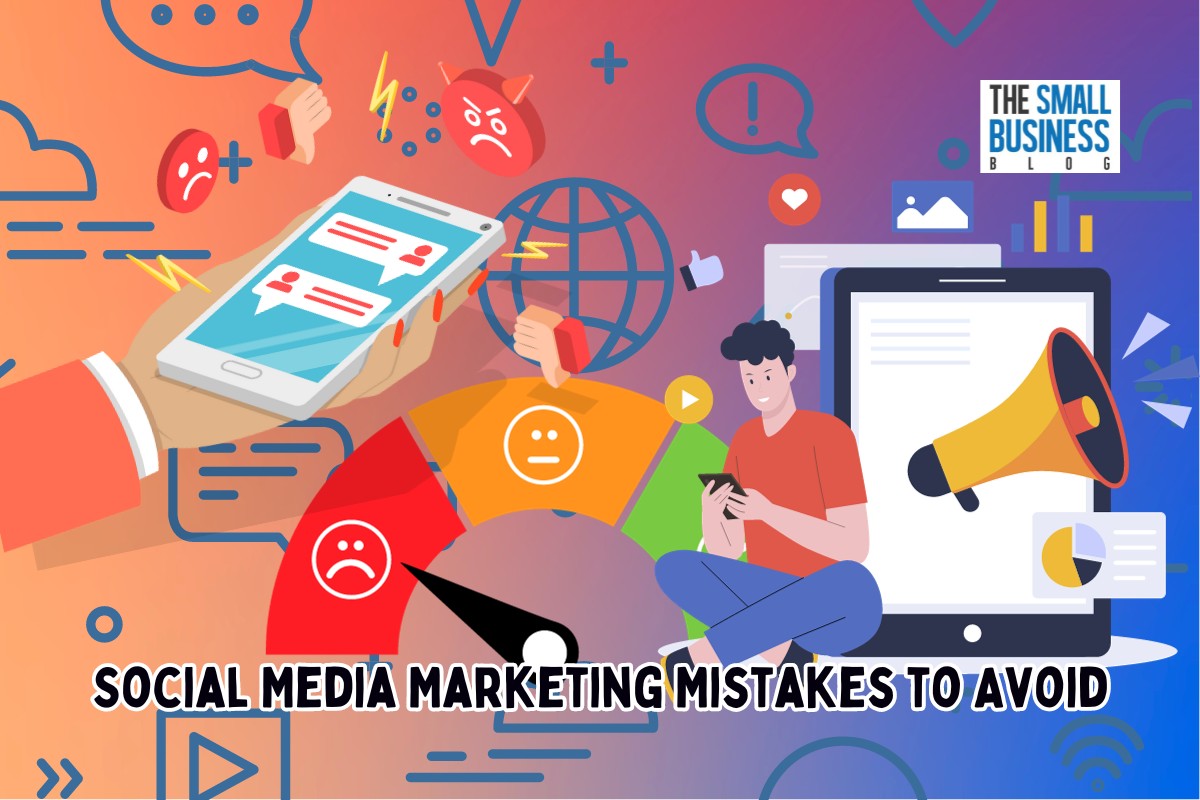In the ever-evolving realm of social media, businesses of all sizes are eagerly jumping onto the digital bandwagon, seeking to harness its vast potential.
However, this journey is fraught with pitfalls, including common social media marketing mistakes to avoid, which can derail even the most well-intentioned marketing strategies.
As we look into the world of social media marketing, it’s crucial to recognize that while the opportunities are immense, the risks of missteps are equally significant.
From small local enterprises to established brands, the allure of social media’s extensive reach is undeniable.
Yet, the path to digital success is often littered with these errors that can compromise a brand’s online presence and credibility.
Post Contents
- 1 Social Media Marketing Mistakes to Avoid
- 1.1 1. Ignoring Social Media Analytics
- 1.2 2. Inconsistent Posting
- 1.3 3. Over-Promotion
- 1.4 4. Ignoring Customer Feedback
- 1.5 5. Failing to Understand the Platform
- 1.6 6. Not Defining a Target Audience
- 1.7 7. Neglecting Visual Content
- 1.8 8. Overlooking Mobile Optimization
- 1.9 9. Not Utilizing Social Media Advertising
- 1.10 10. Poor Crisis Management
- 1.11 11. Using Irrelevant Hashtags
- 1.12 12. Ignoring the Importance of Community Building
- 1.13 13. Not Tracking ROI
- 1.14 14. Posting Irrelevant Content
- 1.15 15. Not Engaging in Real-Time
- 1.16 16. Lack of Brand Consistency
- 1.17 17. Not Leveraging User-Generated Content
- 1.18 18. Failing to Use Analytics for Content Strategy
- 1.19 19. Not Personalizing Content
- 1.20 20. Ignoring SEO in Social Media
- 1.21 21. Not Updating Social Media Skills
- 2 FAQs
- 3 Conclusion
Social Media Marketing Mistakes to Avoid
By understanding and sidestepping the following blunders, brands can navigate the digital terrain with greater confidence and effectiveness, ensuring their social media endeavors yield fruitful and enduring results.
1. Ignoring Social Media Analytics

Neglecting social media analytics is a common mistake in social media marketing.
Analytics provide crucial insights into audience behavior, preferences, and engagement patterns.
By not analyzing this data, businesses miss out on opportunities to refine their strategies and content.
Understanding which posts perform well and why can help tailor future content to better resonate with the audience.
Regularly reviewing and acting on analytics data is essential for a successful social media strategy.
2. Inconsistent Posting
Inconsistent posting can significantly undermine your social media presence.
A sporadic posting schedule can lead to a disengaged audience, as followers prefer predictability and regularity.
Establishing a consistent posting schedule helps in building a loyal following, as audiences appreciate and look forward to regular updates.
It’s not just about frequency but also about maintaining a steady rhythm in your content delivery.
Utilizing scheduling tools can aid in planning and maintaining this consistency, ensuring your audience remains engaged and connected to your brand.
3. Over-Promotion
Over-promotion is a common pitfall in social media marketing.
While promoting products or services is essential, excessive self-promotion can alienate your audience.
The key is to find a balance between promotional content and content that provides value in the form of information, entertainment, or education.
A good rule of thumb is the 80/20 rule, where 80% of your content is customer-focused and only 20% is about your brand.
This approach ensures that your audience stays engaged and doesn’t feel overwhelmed by constant sales pitches.
4. Ignoring Customer Feedback
Ignoring customer feedback on social media platforms is a critical mistake.
Social media is a two-way communication channel, not just a platform for broadcasting messages.
Engaging with your audience by responding to comments, messages, and reviews, whether they are positive or negative, is crucial.
It demonstrates that you value customer input and are committed to improving their experience with your brand.
This engagement can also provide valuable insights into customer preferences and help in refining your products or services.
5. Failing to Understand the Platform

Each social media platform has its own set of unique features, audience demographics, and best practices.
Failing to understand these nuances can lead to ineffective and misplaced marketing efforts.
What works on one platform may not necessarily work on another.
For instance, the content that resonates on Instagram might not have the same impact on LinkedIn.
It’s crucial to tailor your content and approach to suit each platform’s specific audience and format, thereby maximizing the effectiveness of your social media strategy.
6. Not Defining a Target Audience

Not having a clear understanding of your target audience is a common mistake in social media marketing.
Without a well-defined target audience, your content may not resonate with the people you are trying to reach.
Defining a target audience helps in creating more focused and relevant content, which is more likely to engage and convert.
This involves understanding the demographics, interests, and behaviors of your ideal customers and tailoring your content to meet their needs and preferences.
7. Neglecting Visual Content
In today’s visually-driven social media landscape, underestimating the power of visual content is a significant oversight.
Visuals, whether images, videos, or infographics, tend to be more engaging and shareable than text-only posts.
Investing in high-quality, compelling visuals can significantly enhance your social media presence and engagement.
Visual content should not only be eye-catching but also relevant and aligned with your brand message, ensuring it resonates with your audience and reinforces your brand identity.
8. Overlooking Mobile Optimization
With the majority of social media browsing occurring on mobile devices, overlooking mobile optimization can be detrimental to your online presence.
Ensuring that your content is mobile-friendly is crucial for effective engagement.
This includes optimizing images and videos for mobile viewing and ensuring that any linked content, such as blogs or landing pages, is mobile-responsive.
A mobile-optimized experience is essential for keeping your audience engaged and ensuring they have a positive interaction with your brand on social media.
9. Not Utilizing Social Media Advertising
Failing to utilize social media advertising is a missed opportunity for many businesses.
Paid social media ads can significantly increase your reach and allow you to target specific audiences effectively.
With advanced targeting options, social media ads can be a cost-effective way to enhance your online presence and reach potential customers who may not have discovered your brand otherwise.
It’s important to create compelling ad content and use targeting features wisely to ensure your advertising budget is spent effectively.
10. Poor Crisis Management
Poor crisis management on social media can quickly escalate into a larger problem for your brand.
It’s important to have a crisis management plan in place for handling negative feedback or public relations issues.
This includes monitoring your social media channels for any negative feedback and responding promptly and appropriately to mitigate any issues.
A well-handled crisis can even turn a negative situation into a positive one by demonstrating your brand’s commitment to customer service and transparency.
11. Using Irrelevant Hashtags

Using irrelevant or excessive hashtags can make your posts look spammy and unprofessional.
Hashtags should be relevant to your content and audience, and used strategically to increase visibility and engagement.
They are a tool for connecting with new audiences and participating in relevant conversations, but when misused, they can detract from your message and annoy your followers.
Researching and using appropriate hashtags can enhance your content’s reach and ensure it’s seen by the right audience.
12. Ignoring the Importance of Community Building
Social media is about building communities, not just broadcasting messages.
Ignoring the importance of community building can lead to a lack of engagement and a weak online presence.
Engaging with your audience, encouraging discussions, and creating a sense of community can foster loyalty and increase engagement.
This involves actively participating in conversations, sharing user-generated content, and creating content that encourages interaction and discussion among your followers.
13. Not Tracking ROI
Not tracking the return on investment (ROI) of your social media efforts is a significant oversight.
Understanding what you’re getting back from your social media investments, whether in terms of engagement, leads, or sales, is crucial for evaluating the effectiveness of your strategy.
Tracking ROI helps in making informed decisions about where to allocate resources and how to adjust your strategy for better results.
This can involve using analytics tools to track conversions, engagement rates, and other key metrics.
14. Posting Irrelevant Content
Posting content that is irrelevant to your brand or audience can dilute your message and confuse your followers.
It’s important to stay on brand and ensure that all content aligns with your business goals and audience interests.
Irrelevant content can distract from your core message and make your brand seem unfocused.
Staying true to your brand’s voice and values while creating content that resonates with your audience is key to maintaining a strong and cohesive social media presence.
15. Not Engaging in Real-Time
Social media is a real-time platform, and not engaging in real-time can be a missed opportunity for real connection with your audience.
This includes participating in trending topics, responding to comments and messages promptly, and being active when your audience is online.
Real-time engagement shows that your brand is attentive and responsive, which can enhance your reputation and build stronger relationships with your audience.
16. Lack of Brand Consistency

Inconsistency in your brand’s voice and aesthetic across different social media platforms can confuse your audience and weaken your brand identity.
Maintaining a consistent brand identity helps in building brand recognition and trust.
This includes using a consistent tone of voice, visual style, and messaging across all platforms.
A cohesive brand experience helps in creating a strong and memorable brand image.
17. Not Leveraging User-Generated Content
Not leveraging user-generated content is a missed opportunity for many brands.
User-generated content can increase engagement and provide authentic material for your social media channels.
Encouraging your audience to share their experiences with your brand can be a powerful tool for building community and trust.
This content is often seen as more genuine and relatable than brand-created content, making it a valuable asset for your social media strategy.
18. Failing to Use Analytics for Content Strategy
Failing to use analytics to inform your content strategy can lead to less effective content and missed opportunities.
Analytics provide insights into what types of content perform best, allowing you to tailor your strategy accordingly.
This can involve analyzing engagement rates, reach, and audience demographics to understand what resonates with your audience.
Using these insights can help in creating more impactful and relevant content.
19. Not Personalizing Content
Not personalizing content to your audience can make your social media presence feel generic and impersonal.
Personalization, whether through targeted messaging or acknowledging individual comments, can significantly enhance engagement and connection with your audience.
Personalized content shows that you understand and value your audience, leading to stronger relationships and increased loyalty.
20. Ignoring SEO in Social Media
Ignoring the role of SEO in social media can limit your content’s visibility and reach.
Optimizing your social media content for search engines can increase its discoverability and effectiveness.
This includes using relevant keywords, hashtags, and descriptions to ensure your content is easily found by those searching for related topics.
Integrating SEO practices into your social media strategy can enhance your overall online presence.
21. Not Updating Social Media Skills

The social media landscape is constantly evolving, and not updating your skills and knowledge can leave you behind.
Staying informed about the latest trends, tools, and best practices is essential for a successful social media strategy.
This includes learning about new features, algorithm changes, and emerging platforms.
Continuously updating your skills ensures that your social media efforts remain effective and relevant.
FAQs
How Can Businesses Effectively Engage Their Audience on Social Media?
Effective engagement on social media involves regular interaction with the audience, posting relevant and visually appealing content, and personalizing the user experience.
Businesses should respond promptly to comments and messages, encourage user-generated content, and participate in relevant discussions.
Additionally, understanding the best times to post and using analytics to tailor content can significantly enhance audience engagement.
Why is Consistency Important in Social Media Marketing?
Consistency in social media marketing is vital for building brand recognition and trust.
This includes maintaining a consistent posting schedule, using a uniform tone of voice, and ensuring visual elements align with the brand’s identity across all platforms.
Consistency helps in establishing a recognizable brand presence, making it easier for audiences to connect with and remember the brand.
Conclusion
Navigating the world of social media marketing mistakes to avoid requires a blend of strategy, creativity, and awareness of common pitfalls.
By understanding and avoiding these social media marketing mistakes, businesses can enhance their online presence, engage more effectively with their audience, and achieve their marketing goals.
Remember, successful social media marketing isn’t just about avoiding errors; it’s about crafting a thoughtful, dynamic approach that resonates with your audience and reflects your brand’s unique voice.






























